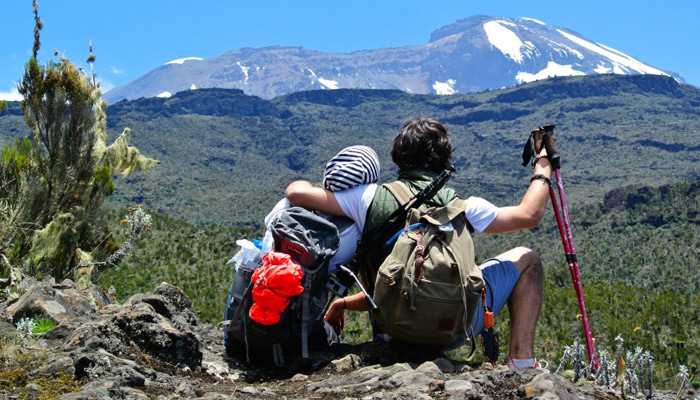6-Day Rongai Route – Kilimanjaro Trekking Tour
Quiet wilderness route approaching Kilimanjaro from the north with a gradual ascent and high success rate..

Why Choose the 6-Day Rongai Route?
The Rongai Route is Kilimanjaro’s only northern approach, offering a more remote and less crowded trekking experience. It’s ideal for those looking to avoid the busier trails while enjoying diverse scenery and good acclimatization. Starting from the north near the Kenyan border, you’ll hike through forest, moorland, and alpine desert zones before joining the Marangu Route for your descent.
| Feature | Details |
|---|---|
| Duration | 6 Days |
| Route Distance | ~73 km (45 miles) |
| Difficulty | Moderate |
| Accommodations | Mountain Huts |
| Best Months | Jan–Mar & Jun–Oct |
6-Day Rongai Route Itinerary
Day 1: Rongai Gate to Simba Camp
Altitude: 2,000m to 2,650m
Time: 4–5 hours
Habitat: Montane Forest
Begin your trek from Rongai Gate through dense montane forest. The trail is gradual, allowing for a gentle introduction to the climb. Watch for Colobus monkeys and colorful birds along the way. The hike ends at Simba Camp, located on the edge of the moorland zone, offering your first views of the summit.
Altitude: 2,650m to 3,450m
Time: 6–7 hours
Habitat: Moorland
Hike steadily upward through heather and moorland. Enjoy panoramic views of Kenya’s plains as you reach Second Cave Camp, nestled beneath towering Kibo.
Altitude: 3,450m to 3,900m
Time: 3–4 hours
Habitat: Moorland
A shorter acclimatization day with a gradual ascent to Third Cave. You'll notice the landscape becoming drier and rockier as you enter the alpine zone.
Altitude: 3,900m to 4,700m
Time: 4–5 hours
Habitat: Alpine Desert
Cross the saddle between Mawenzi and Kibo to reach Kibo Hut at the base of the summit. Prepare for your midnight ascent to Uhuru Peak
Altitude: 4,700m to 5,895m (Uhuru Peak), then down to 3,720m
Time: 12–15 hours total
Habitat: Arctic to Moorland
Begin the final push around midnight. Hike steep switchbacks to Gilman’s Point, then continue along the crater rim to Uhuru Peak – the highest point in Africa. After celebrations and photos, descend to Horombo Hut for rest.
Altitude: 3,720m to 1,860m
Time: 6–8 hours
Habitat: Moorland & Rainforest
Descend through heath and lush forest to reach Marangu Gate. Collect your summit certificate and say farewell to your mountain crew.
What’s Included in the 6-Day Trek
✅ Park fees
✅ Rescue fees
✅ Guide, cook, and porters
✅ Mountain huts accommodation
✅ Meals and drinking water
✅ Transfers to/from Kilimanjaro gate
What’s Not Included
❌ Flights
❌ Visa fees
❌ Tips for guides and porters
❌ Personal trekking gear and equipment
| Group Size | Price per Person |
|---|---|
| 1 Trekker | $2,050 |
| 2–4 Trekkers | $1,820 |
| 5-9 Trekkers | $1,695 |
| 10+ Trekkers | $1,580 |
Discounts available for larger groups. Contact us for custom quotes.
Ready to Climb Kilimanjaro?
Secure Online Payments
We accept secure online payments for all confirmed bookings. To protect your payment, please only pay via the official payment link you receive from our official channels:
Request Payment via Email Request Payment via WhatsApp
Once your booking is confirmed, we require a 30% down payment to secure your spot. The remaining balance can be paid in cash or via POS machine when you arrive at your hotel or our office. This ensures your booking is reserved while giving you flexible payment options.
Why Trek Kilimanjaro With Tanzania Trip Service?
Local experienced guides
Focus on safety and proper acclimatization
High summit success rate
24/7 WhatsApp support
Faqs
A: The best route depends on your goals. Lemosho and Northern Circuit are great for acclimatization and scenery. Machame is popular and scenic, Marangu has huts, Rongai is dry and quiet, and Umbwe is very steep and challenging.
A: The Lemosho and Northern Circuit routes are considered the most scenic, offering panoramic views from all sides of Kilimanjaro.
A: The Northern Circuit has the highest summit success rate due to its long duration and excellent acclimatization profile.
A: Marangu offers hut accommodations and a gentle trail, but its shorter duration makes acclimatization more difficult. It's more comfortable but not necessarily easier to summit.
A: All routes except Marangu require camping. Marangu is the only route with mountain huts along the way.
A: 6 to 9 days is ideal. Shorter routes are possible but reduce summit success rates due to limited acclimatization time.
A: The best months are January to March and June to October, which are dry seasons with clear skies and stable weather.
A: Yes, guides are mandatory. Kilimanjaro National Park regulations require all climbers to be accompanied by licensed guides and a mountain crew.
A: You don’t need technical climbing skills, but you should be in good physical shape with strong endurance and mental determination.
A: Rongai, Northern Circuit, and parts of Lemosho are quieter and more remote, making them great options for avoiding crowds.
